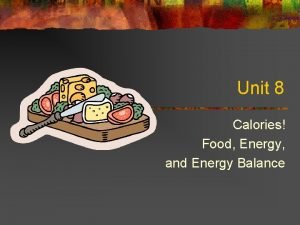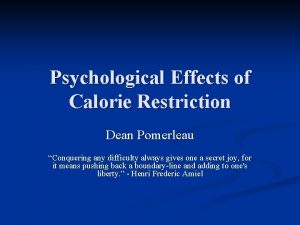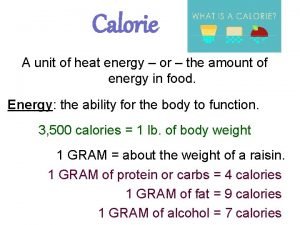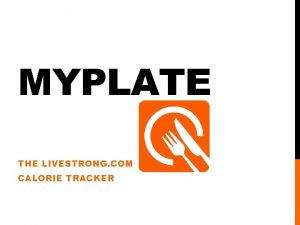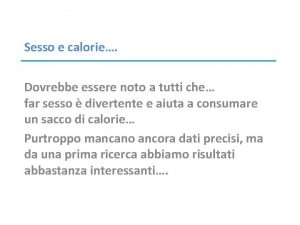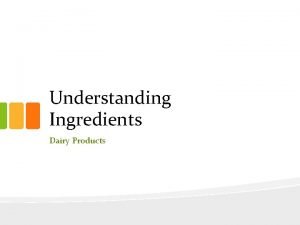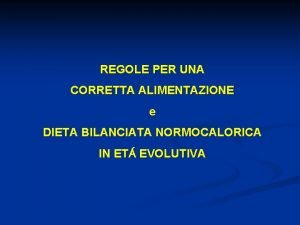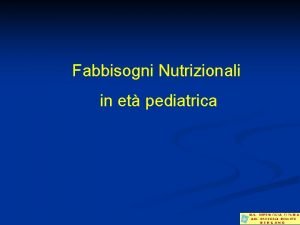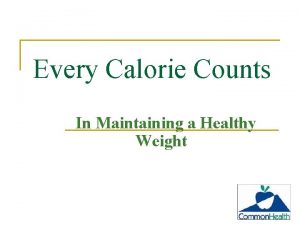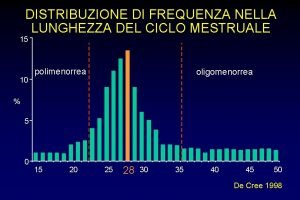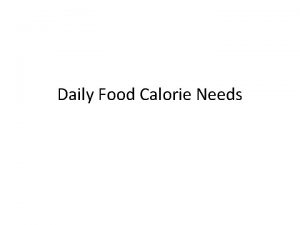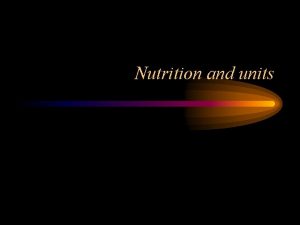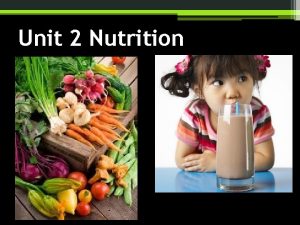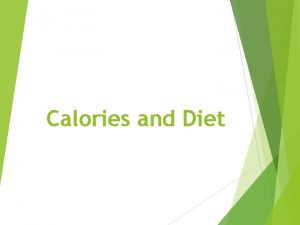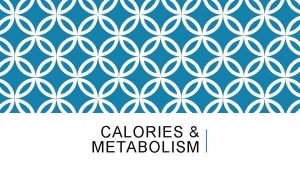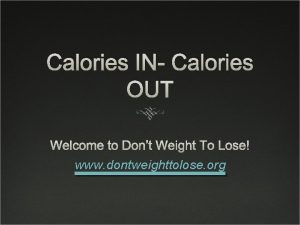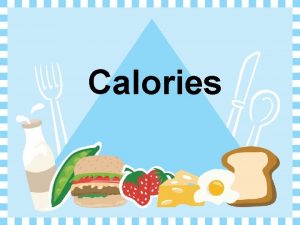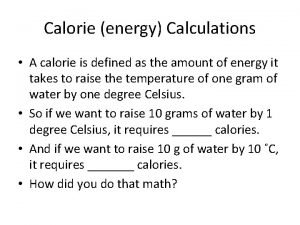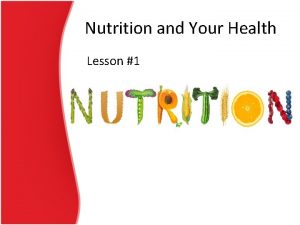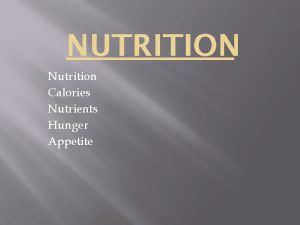Nutrition and units calories A calorie is the















- Slides: 15

Nutrition and units

calories • A calorie is the old chemistry metric unit for energy. • A calorie is the amount of energy required to raised 1 g of water 1 degree Celsius. • In science, there was a broad unification movement to make all sciences use the same units. • A joule was the amount of energy commonly used in physics. • It is the amount of energy required to accelerate a 1 kg object 1 m/s 2 for 1 m, or apply 1 N of force for 1 m.

Nutrition and Calories • Calorie is an energy measurement just like joules. • Calories reported on food labels are actually kilocalories (it does have to be capitalized). • 1 Cal = 1000 cal = 4. 183 k. J • The calories in a food are the amount of energy released during the metabolism reaction of that food.

Elsewhere • Other countries are switching their food labels to match the science standard.

Bomb Calorimeter • In the past food, was placed in a bomb calorimeter, a sealed container to stop heat transfer, and burned to check the amount of energy released. • The heat was used to heat water and it could be calculated. • This led to some problems as certain things we eat are indigestible, but they are burnable

Bomb Calorimeter

Better calculations • Now, the amount of proteins, carbohydrates, and fats are separated and measured. • We can calculate the caloric content from that and get a much better measure of the energy content of food.

Energy content in foods • • carbohydrate – 4 Cal/g protein – 4 Cal/g fat – 9 Cal/g There is more you need from food than just energy (vitamins, minerals etc. ). • There is a certain amount of Calories you need to function. • This amount differs for each person, and differs over time. • Striking an appropriate balance between these is a healthy diet.

Continued… • The energy from food is used by your body for everything it does (powering muscles, building new cells, controlling body temperature etc. ). • If you take in less than you need your body cannot function properly (car without gas). • If you take in more than you use, it is stored as fat or glycogen, organic compounds that can be digested later.

Storage • The ability of your body to store energy is NOT bad. • You would have to eat every hour of your life to survive if you couldn’t store energy. • Excess long term storage of fat is not healthy for your body. • Several methods of removing the excess fat are not healthy either.

Enthalpy • ~A measure of heat energy content of a reaction. • The symbol for enthalpy is H • Enthalpy can only be measured as a change from a standard state. • Negative values mean the energy is released (exothermic). • Positive value mean the energy is absorbed (endothermic).

How is that different from q • q is the change in heat energy. • Enthalpy is the change in heat energy per mole for a process or reaction. • H = q/n • so it is measured in J/mol • 2 H 2 + O 2 → 2 H 2 O H = -572 k. J/mol • This means if the reaction is run once with 2 moles of H 2 and one mole of O 2, 572 k. J of energy are released

Hess’s Law • ~In going from a set of reactants to a set of products the change in enthalpy will be the same regardless of how it changed. • There is more than one way for a set of reactants to produce a set of products. The overall energy change will be the same no matter how you get there.

Hess’s Law example • N 2 + 2 O 2 → 2 NO 2 • Or • N 2 + O 2 → 2 NO • 2 NO + O 2 → 2 NO 2 • H = 68 k. J H = 180 k. J H = -112 k. J 68 k. J

Another Hess’s Law example Cgraphite + O 2 CO 2 H = -394 k. J/mol Cdiamond + O 2 CO 2 H = -396 k. J/mol • Calculate H for the conversion of graphite to diamond: • Cgraphite(s) Cdiamond(s) • H for the reverse of a reaction will be the opposite sign.
 Biobeyond unit 8 counting calories
Biobeyond unit 8 counting calories Biochemical units of nutrition
Biochemical units of nutrition Dean pomerleau
Dean pomerleau Différence entre calorie et kilocalorie
Différence entre calorie et kilocalorie 1 oz chicken
1 oz chicken Livestrong food tracker
Livestrong food tracker Cestbeaulavie
Cestbeaulavie Calorie sesso
Calorie sesso Raw milk fat percentage
Raw milk fat percentage Esempio dieta bilanciata
Esempio dieta bilanciata Calorie restriction
Calorie restriction Noci calorie
Noci calorie Larn bambini
Larn bambini Superfoods
Superfoods Dieta per menopausa 1200 calorie
Dieta per menopausa 1200 calorie Calcolo fabbisogno calorico giornaliero
Calcolo fabbisogno calorico giornaliero
